Dji Flagship for Digital Agriculture AGRAS T30 User Manual
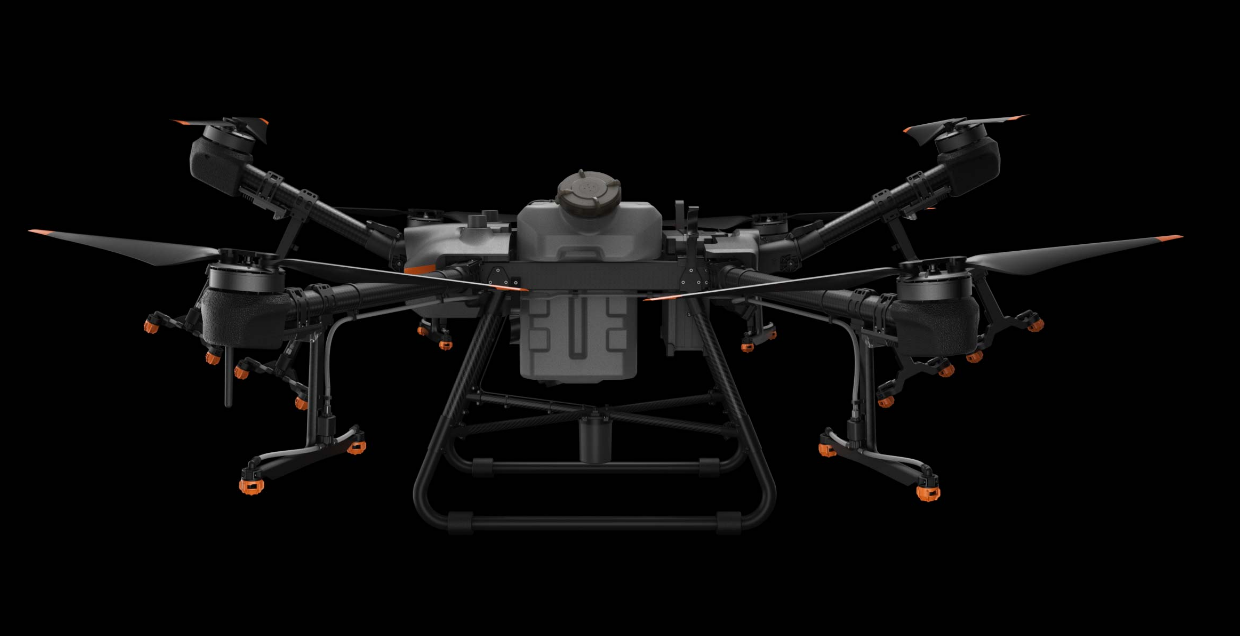
Content
DJI Flagship for Digital Agriculture AGRAS T30 Introduction
The Agras T30 is DJI’s next-generation aircraft with a max payload of up to 40 kg. It features a revolutionary transforming structure and advanced digital agriculture solutions to enhance the efficiency of crop protection operations. The new Route Operation mode includes Connection Routing, allowing the aircraft to automatically avoid obstacles marked during field planning.
The Agras T30 is equipped with a Spherical Radar System for terrain following, obstacle sensing, and circumventing. With dual FPV cameras and bright spotlights, it ensures operational safety both day and night in various weather conditions.
Detailed Specifications
Airframe
- Max Diagonal Wheelbase: 2145 mm
- Dimensions:
- 2858×2685×790 mm (arms and propellers unfolded)
- 2030×1866×790 mm (arms unfolded and propellers folded)
- 1170×670×857 mm (arms and propellers folded)
Propulsion System
- Motors Max Power: 3600 W/rotor
- ESCs Max Working Current (Continuous): 60 A
- Foldable Propellers (R3820): Diameter x Pitch 38×20 in
Spraying System
- Spray Tank Volume: Fully loaded: 30 L
- Operating Payload: Fully loaded: 30 kg
- Nozzles Model:
- XR11001VS (standard)
- XR110015VS (optional, purchase separately)
- TX-VK4/X-VK4 (optional for Orchard Configuration, purchase separately)
- Nozzles Quantity: 16
- Max Spray Rate:
- XR11001VS: 7.2 L/min
- XR110015VS: 8 L/min
- Spray Width: 4-9 m (12 nozzles, at a height of 1.5-3 m above crops)
- Droplet Size:
- XR11001VS: 130-250 um
- XR110015VS: 170-265 um (subject to operating environment and spray rate)
- Flow Meter Measurement Range: 0.25-20 L/min
- Flow Meter Error: <+2%
- Measurable Liquid: Conductivity >50 uS/cm (liquids such as tap water or pesticides that contain water)
Omnidirectional Digital Radar
- Model: RD2424R
- Operating Frequency: SRRC/NCC/FCC/MIC/KCC/CE: 24.05-24.25 GHz
- Power Consumption: 12 W
- Transmission Power (EIRP):
- SRRC: ≤13 dBm
- NCC/MIC/KCC/CE/FCC: ≤20 dBm
- Altitude Detection Range: 1-30 m
- Stabilization Working Range: 1.5-15 m
- Max Slope in Mountain Mode: 35°
- Obstacle Sensing Range: 1.5-30 m
- Field of View (FOV): Horizontal: 360°, Vertical: +15°
- IP Rating: IP67
Upward Radar
- Model: RD2414U
- Operating Frequency: SRRC/NCC/FCC/MIC/KCC/CE: 24.05-24.25 GHz
- Power Consumption: 4 W
- Transmission Power (EIRP):
- SRRC: ≤13 dBm
- NCC/MIC/KCC/CE/FCC: ≤20 dBm
- Obstacle Sensing Range: 1.5-15 m
- FOV: 80°
- IP Rating: IP67
FPV Cameras
- FOV: Horizontal: 129°, Vertical: 82°
- Resolution: 1280x720, 15-30fps
FPV Spotlights
- FOV: 120°
- Max Brightness: 13.2 lux at 5 m of direct light
Flight Parameters
- Operating Frequency:
- SRRC/NCC/FCC/CE/MIC/KCC: 2.4000-2.4835 GHz
- SRRC/CE/MIC/KCC: 5.725-5.850 GHz
- Total Weight (excluding battery): 26.3 kg
- Max Takeoff Weight for Spraying: 66.5 kg (at sea level)
- Max Takeoff Weight for Spreading: 78 kg (at sea level)
- Hovering Accuracy Range (with strong GNSS signal):
- D-RTK enabled: Horizontal: ±10 cm, Vertical: ±10 cm
- D-RTK disabled: Horizontal: ±0.6 m, Vertical: ±0.3 m (Radar module enabled: ±0.1 m)
- RTK/GNSS Operating Frequency:
- RTK: GPS L1/L2, GLONASS F1/F2, BeiDou B1/B2, Galileo E1/E5
- GNSS: GPS L1, GLONASS F1, Galileo E1
- Battery Max Power Consumption: 13000 W
- Hovering Time:
- 20.5 min (takeoff weight of 36.5 kg with a 29000 mAh battery)
- 7.8 min (takeoff weight of 66.5 kg with a 29000 mAh battery)
- Max Tilt Angle: 15°
- Max Operating Speed: 7 m/s
- Max Flying Speed: 10 m/s (with strong GNSS signal)
- Max Wind Resistance: 8 m/s
- Max Service Ceiling Above Sea Level: 4500 m
- Recommended Operating Humidity: <93%
- Recommended Operating Temperature: 0° to 45°C (32°F to 113°F)
Remote Controller
- Model: RM500-ENT
- RAM: 4GB
- Built-in Battery: 18650 Li-ion (5000 mAh @ 7.2 V)
- GNSS: GPS+GLONASS
- Power Consumption: 18 W
- Operating Temperature: 0° to 45°C (32°F to 113°F)
- Charging Environment Temperature: 5° to 40°C (41°F to 104°F)
- Storage Temperature:
- < 1 month: -30° to 60°C (-22°F to 140°F)
- 1-3 months: -30° to 45°C (-22°F to 113°F)
- 3-6 months: -30° to 35°C (-22°F to 95°F)
- 6 months: -30° to 25°C (-22°F to 77°F) (Built-in battery power 40%-60%)
OcuSync Enterprise
- Operating Frequency:
- SRRC/NCC/FCC/CE/MIC/KCC: 2.4000-2.4835 GHz
- SRRC/NCC/FCC/CE: 5.725-5.850 GHz
- Max Transmission Distance (Unobstructed, free of interference):
- FCC/NCC: 7 km
- SRRC: 5 km
- MIC/KCC/CE: 4 km
Wi-Fi
- Protocol: Wi-Fi Direct, Wi-Fi Display, 802.11a/g/n/ac
- Operating Frequency:
- 2.4000-2.4835 GHz
- 5.150-5.250 GHz
- 5.725-5.850 GHz
- Transmission Power (EIRP):
- 2.4 GHz: SRRC/CE: 18.5 dBm, NCC/FCC/MIC/KCC: 20.5 dBm
- 5.2 GHz: SRRC/NCC/FCC/CE/MIC: 14 dBm, KCC: 10 dBm
- 5.8 GHz: SRRC/NCC/FCC: 18 dBm, CE/KCC: 12 dBm
Bluetooth
- Protocol: Bluetooth 4.2
- Operating Frequency: 2.4000-2.4835 GHz
- Transmission Power (EIRP): SRRC/NCC/FCC/CE/MIC/KCC: 6.5 dBm
Remote Controller Intelligent Battery
- Model: WB37-4920mAh-7.6V
- Battery Type: 2S LiPo
- Capacity: 4920 mAh
- Voltage: 7.6 V
- Energy: 37.39 Wh
- Charging Environment Temperature: 5° to 40°C (41°F to 104°F)
Intelligent Battery Charging Hub
- Model: WCH2
- Input Voltage: 17.3-26.2 V
- Output Voltage and Current: 8.7 V, 6 A
- Operating Temperature: 5° to 40°C (41°F to 104°F)
AC Power Adapter
- Model: A14-057N1A
- Input Voltage: 100-240 V, 50/60 Hz
- Output Voltage: 17.4 V
- Rated Power: 57 W
Aircraft Overview
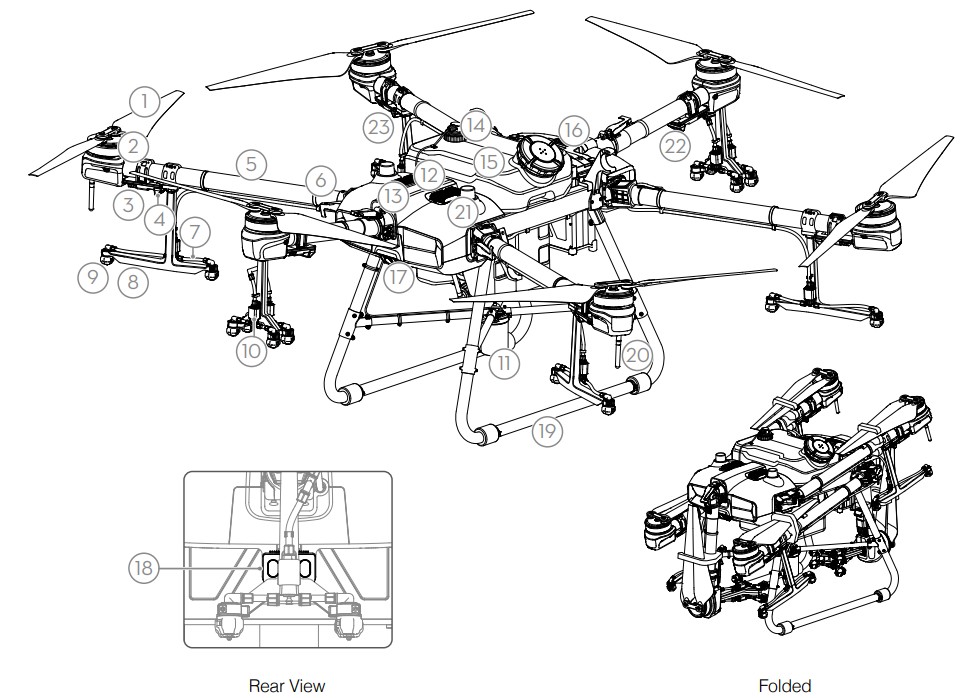
- Propellers
- Motors
- ESCs
- Aircraft Front Indicators (on the M2 and M6 arms)
- Frame Arms
- Folding Detection Sensors (built-in)
- Hoses
- Sprinklers
- Nozzles
- Electromagnetic Exhaust Valves
- Omnidirectional Digital Radar
- Upward Radar (built-in)
- Heat Sinks
- Liquid Level Gauge
- Spray Tank
- Battery Compartment
- Forward FPV Camera
- Backward FPV Camera
- Landing Gear
- OcuSync Antennas
- Onboard D-RTK Antennas
- Aircraft Status Indicators (on the M1 and M4 arms)
- Aircraft Rear Indicators (on the M3 and M5 arms)
Remote Controller Overview
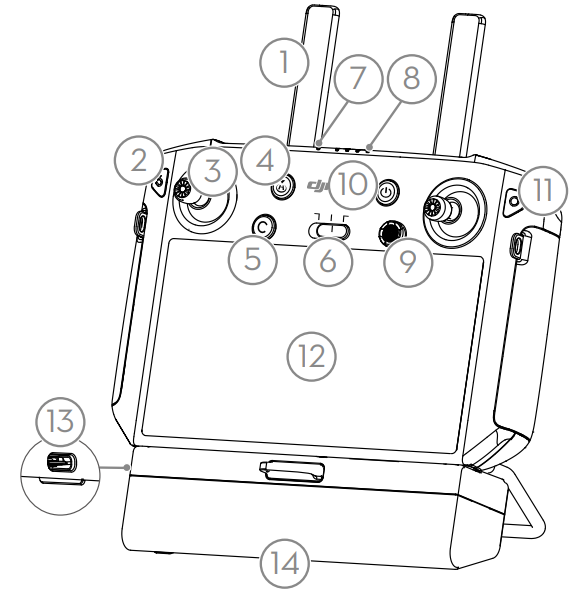
- Antennas
Relays aircraft control and image transmission signals. - Back Button / Function Button
Press once to return to the previous page. Hold to view a guide to using button combinations. Refer to Button Combinations (p. 38) for more information. - Control Sticks
Controls aircraft movement. Control mode can be set in the app. - RTH Button
Press and hold this button to initiate Return to Home (RTH). - Button C3 (customizable)
- Flight Mode Switch
The three positions are P-mode (Positioning), A-mode (Attitude), and P-mode (Positioning). - Status LED
Indicates whether the remote controller is linked to the aircraft. - Battery Level LEDs
Displays current battery level of the internal battery. - 5D Button (customizable)
- Power Button
Used to power the remote controller on and off. When the remote controller is powered on, press the button to enter sleep mode or wake up the controller. - Confirm Button
Press to confirm a selection. - Touch Screen
Tap to select. Android-based device to run DJI Agras. - USB-C Charging Port
Use to charge the remote controller. - Dongle Compartment Cover
Open the cover to mount or remove the 4G dongle. - Spray Rate Dial
Turn to adjust the spray rate in Manual operation mode. - Spray Button
Press to start or stop spraying in Manual operation mode. - HDMI Port
For video output. - microSD Card Slot
Used to insert a microSD card. - USB-A Port
Used to connect devices such as an RTK Dongle, or to connect to a computer to update firmware and export logs via the DJI Assistant 2 software. - FPV / Map Switch Button
In Operation View in DJI Agras, press to switch between FPV and the Map View. - Reserved Dial
- Air Outlet
Used for heat dissipation. DO NOT cover the air vent during use. - Button C1 (customizable)
When planning a field, press the button to switch between Obstacle mode and Waypoints mode. The function of the button cannot be customized while planning a field. When not planning a field, use the app to customize the button. - Button C2 (customizable)
When planning a field, press the button to add a waypoint or an obstacle point. The function of the button cannot be customized when planning a field. When not planning a field, use the app to customize the button. - Battery Cover
Open the cover to mount or remove the Intelligent Battery from the remote controller. - Battery Compartment Cover Lock
Press the lock to open the cover. - Handle
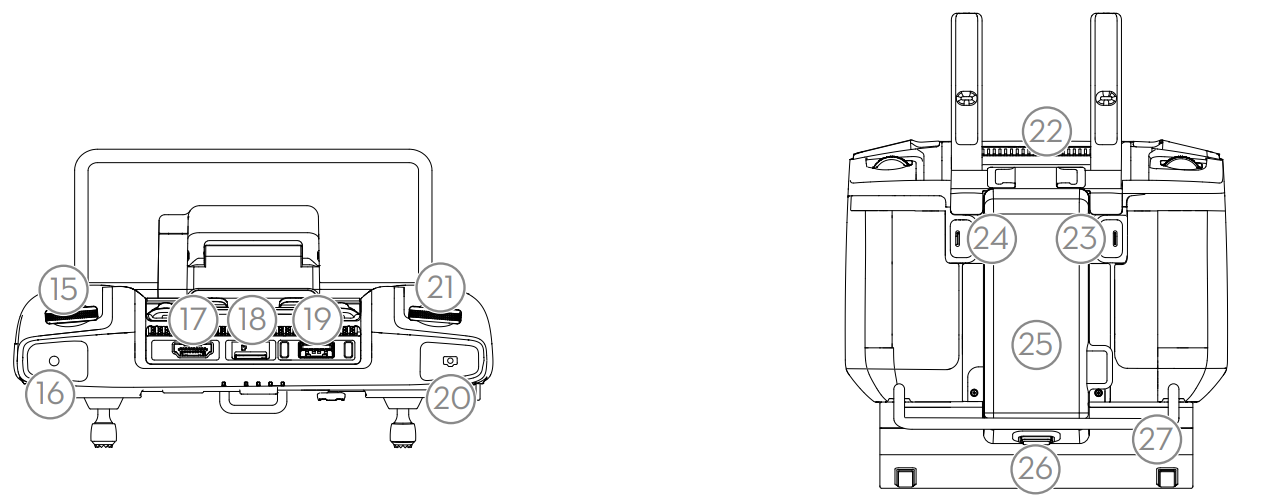
Aircraft Status Indicators Description
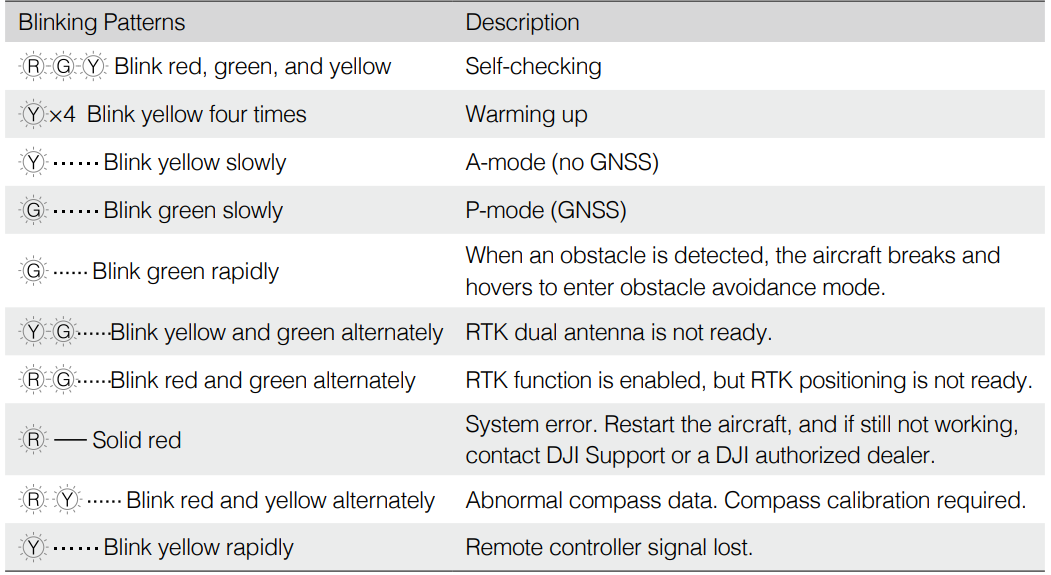
Feature Highlights
The updated Route operation mode includes Connection Routing. In Connection Routing, the aircraft will automatically retum to a task route. Users can mark obstacles outside the task area during field planning for the aircraft to avoid and also add connection points for the aircraft to travel through along the connection route back to the task route. Operations are further automated by the Smart Supply Reminder, which calculates the remaining liquid amount in real time and displays the refill point on the map \
The crosshair can be used to add boundary and obstacle points in field planning, making operations easier than ever for users. The aircraft can perform variable rate fertilization by importing prescription maps to the remote controller and applying them to fields.
The Spherical Radar System consists of the Omnidirectional Digital Radar and Upward Radar, providing altitude detection and stabilization in forward, backward, and downward directions as well as obstacle sensing in all horizontal directions and upward direction when in Route, A-B Route, and
Manual Plus operation modes. The radar can detect the angle of a slope and automatically adjust to maintain the same distance with the surface even in mountainous terrain. In Route and A-B Route operation modes, the radar can effectively sense obstacles and plan a route to actively circumvent obstacles. Obstacle circumvention is disabled by default and must be enabled in the app.
The spraying system is equipped with plunger pumps and a continuous liquid level gauge to offer even and accurate spraying. DJI provides an optional 130 Orchard Spray Package, which enablesusers to change the T30 to the Orchard configuration. When using the package and DJI's unique branch-targeting technology, the 130 can penetrate thick canopies for more precise and efficient spraying operations.
Multi-Aircraft Control mode enables users to coordinate the operation of multiple aircraft simultaneously with one remote controller. Users can switch between different aircraft in the app.
Description
The AGRAS T30 boasts a rugged design built to withstand harsh agricultural environments. Its modular architecture allows for easy maintenance and quick swapping of payloads, ensuring minimal downtime. The drone is equipped with advanced sensors and navigation systems, enabling precise flight and accurate payload delivery. The integrated camera system provides high-resolution images for crop health monitoring and analysis.
The AGRAS T30 also features a smart spraying system that automatically adjusts flow rate and spray width based on the speed of the drone, ensuring uniform coverage and minimizing chemical waste. This intelligent design makes it an efficient tool for large-scale agricultural operations.
Preparing the Aircraft
- Unfold the M2 and M6 arms, and fasten the two arm locks. Avoid pinching fingers.
Unfold the M3 and M5 arms followed by M1 and M4 and fasten the four arm locks. Avoid pinching fingers.
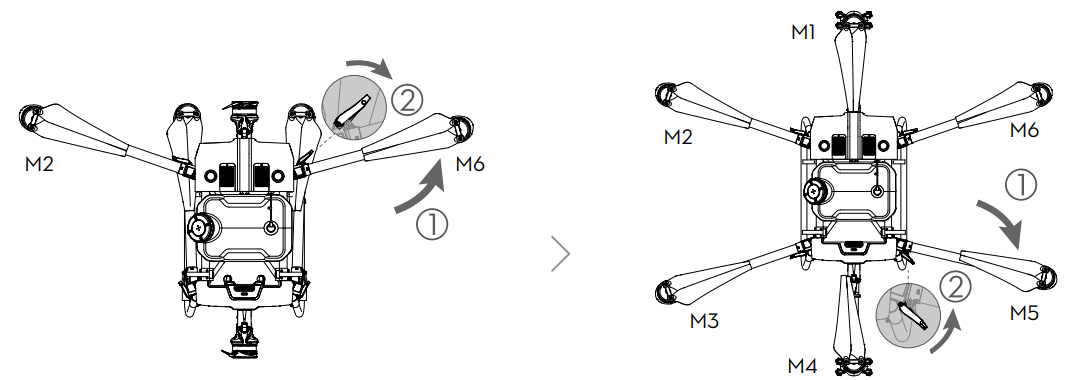
- Unfold the propeller blades.
Insert the Intelligent Flight Battery into the aircraft until you hear a click.
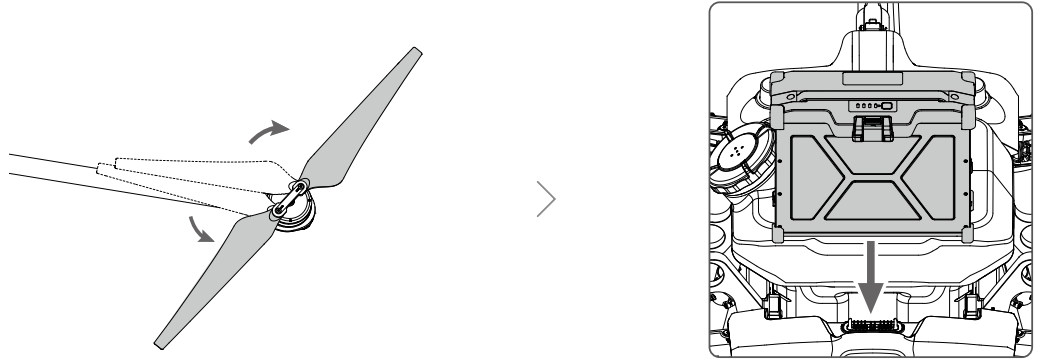
WARNING
- Make sure that the battery is firmly inserted into the aircraft. Only insert or remove the battery when the aircraft is powered off.
- To remove the battery, press and hold the clamp and lift the battery up.
- Fold the M3 and M5 ams followed by the M2 and M6 arms and make sure that the arms are inserted into the storage clamps on both sides of the aircraft. Otherwise, the arms may be damaged. Lift and lower the M1 and M4 arms gently to reduce wear and tear.
Preparing the Remote Controller
Mounting the External Battery
- Press the battery cover release button on the back of the remote controller down to open the cover.
- Insert the Intelligent Battery into the compartment and push it to the top.
Close the cover.
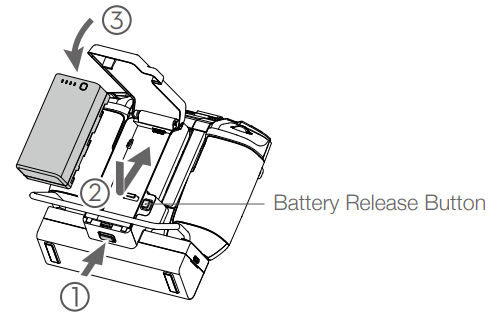
NOTE: To remove the Intelligent Battery, press and hold the battery release button and push the battery downward.
Mounting the 4G Dongle and SIM Card
Only use a DJI-approved dongle. The dongle supports various network standards. Use a SIM card that is compatible with the chosen mobile network provider and select a mobile data plan according to the planned level of usage.
The dongle and SIM card enable the remote controller to access specific networks and platforms such as the DJI Agras Management Platform. Make sure to insert them correctly. Otherwise, network access will not be available.
- Remove the dongle compartment cover.
- Make sure the SIM card is inserted into the dongle.
Insert the dongle into the USB port and test the dongle.* Reattach the cover firmly.
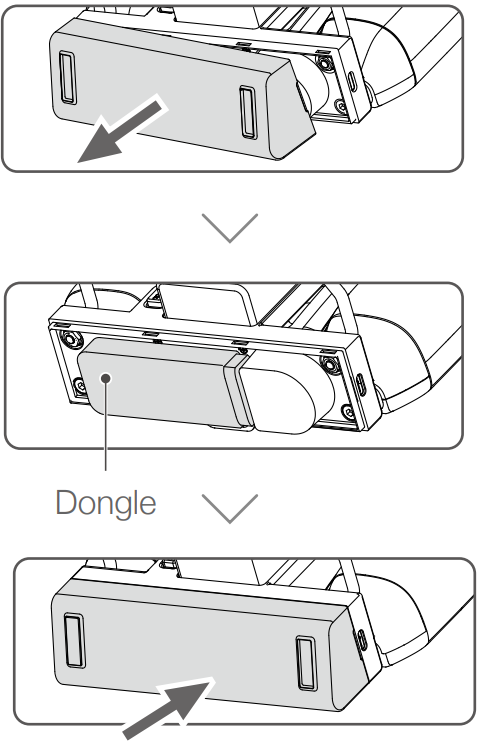
Test procedure: press the remote controller power button and press again and hold to power on the remote controller. In DJI Agras, tap ‹g›, and select Network Diagnostics. The dongle and SIM card are functioning property if the status of all the devices in the network chain are shown in green.
Mounting the RTK Dongle
When using the RTK planning method to plan the task area, attach the RTK dongle to the USB-A port on the remote controller.

Adjusting the Antennas
Lift and adjust the antennas. The strength of the remote controller signal is affected by the position of the antennas. For an optimal connection between the remote controller and aircraft, make sure the angle between the antennas and the back of the remote controller is 80° or 180°.
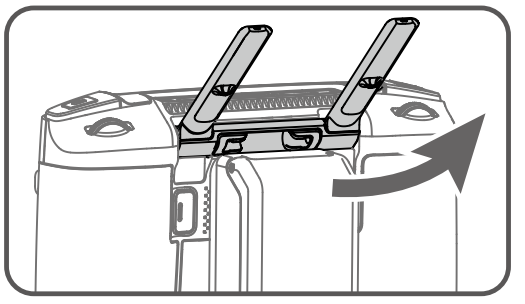
Setup Guide
- Unboxing and Assembly: Carefully unpack the drone and its components. Follow the manual for assembling the propellers, sprayer nozzles, and other attachments.
- Pairing with Controller: Connect the drone to the DJI RC Plus controller via the OcuSync 3.0 system.
- Software Configuration: Update the drone's firmware and configure settings through the DJI FarmCode app.
- Calibration: Perform calibration steps for the propellers, compass, and other critical components as instructed in the manual.
Safety at a Glance
Warning: The Agras T30 aircraft is not a toy and is not suitable for children under the age of 18. Note that the "Safety at a Glance" section only provides a quick overview of safety tips. Make sure you read and understand the Agras T30/T10 Disclaimer and Safety Guidelines and this user manual.
Pesticide Usage
- Avoid the use of powder pesticides as much as possible as they may reduce the service life of the spraying system.
- Pesticides are poisonous and pose serious risks to safety. Only use them in strict accordance with their specifications.
- Residue on the equipment caused by splashes or spills when pouring and mixing the pesticide can irritate your skin. Make sure to clean the equipment after mixing.
- Use clean water to mix the pesticide and filter the mixed liquid before pouring it into the spray tank to avoid blocking the strainer. Clear any blockage before using the equipment.
- Make sure to stay in an upwind area when spraying pesticide to avoid bodily harm.
- Wear protective clothing to prevent direct body contact with the pesticide. Rinse your hands and skin after handling pesticides. Clean the aircraft and remote controller after applying the pesticide.
- Effective use of pesticides depends on pesticide density, spray rate, spray distance, aircraft speed, wind speed, wind direction, temperature, and humidity. Consider all factors when using pesticides, but DO NOT compromise the safety of people, animals, or the environment in doing so.
- DO NOT contaminate rivers and sources of drinking water.
- Disposal of surplus spray: Plan the spray operation carefully to ensure only enough pesticide for the area is purchased, minimizing surplus spray solution. Any surplus spray or washing liquid in the tank should be applied to the crops or disposed of through an appropriate method.
- DO NOT use strong acids, strong bases, high-temperature liquids, or pesticides that are explicitly prohibited.
Environmental Considerations
- Fly at locations clear of buildings and other obstacles. DO NOT fly above or near large crowds.
- DO NOT fly over 4.5 km (14,763 ft) above sea level.
- Only fly in moderate weather conditions with temperatures between 0° and 45° C (32° and 113° F).
- Ensure your operations comply with applicable laws and regulations. Obtain all necessary authorizations prior to flight.
- DO NOT operate any part of the aircraft indoors.
Pre-Flight Checklist
Ensure the following before flight:
- Remote controller and aircraft batteries are fully charged.
- All parts are in good condition; replace any aged or damaged parts.
- Landing gear and spray tank are securely in place.
- Propellers and frame arms are unfolded, and arm locks are tightly secured. Ensure propellers are in good condition and firmly tightened.
- Ensure no obstructions to the motors, propellers, and the radar module located underneath the aircraft.
- Spraying system is functioning correctly without blockages.
- Compass is calibrated as prompted by the app.
Ingress Protection Rating Description
The Agras T30 is waterproof, dustproof, and corrosion-resistant under normal conditions, with an IP67 rating (excluding the Intelligent Flight Battery). Over time, this rating may decrease due to aging or wear, and water damage is not covered by the product warranty. The protection rating may decrease if:
- There is a collision that deforms the seal structure.
- The shell's seal structure is cracked or damaged.
- Waterproof covers are not properly secured.
Operation
- Stay clear of rotating propellers and motors.
- Ensure the aircraft's max takeoff weight is within the recommended limits.
- The DJI Agras app recommends payload weight limits based on current conditions. Do not exceed these limits to ensure flight safety.
- Maintain a visual line of sight (VLOS) of the aircraft at all times.
- DO NOT use the Combination Stick Command (CSC) or other methods to stop the motors while airborne, unless in an emergency.
- DO NOT answer incoming calls during flight. DO NOT fly under the influence of alcohol or drugs.
- Land at a safe location if there is a low battery warning.
- If the radar module is not functioning correctly, the aircraft may not avoid obstacles during Return to Home (RTH), but speed and altitude can be adjusted if the remote controller is connected.
- After landing, stop the motors, power off the aircraft, and turn off the remote controller to prevent the aircraft from entering Failsafe RTH.
Maintenance and Upkeep
- DO NOT use aged, chipped, or broken propellers.
- Remove or empty the spray tank during transportation or when not in use to avoid damaging the landing gear.
- Recommended storage temperature: between -20° and 40° C (-4° and 104° F).
- Clean the aircraft immediately after spraying and inspect regularly.
Observe Local Laws and Regulations
- Refer to the DJI GEO zones at DJI Fly Safe. Note that DJI GEO zones are not a replacement for local regulations or good judgment.
- Avoid flying at altitudes above 100 m (328 ft). Ensure your flight complies with local laws and regulations.
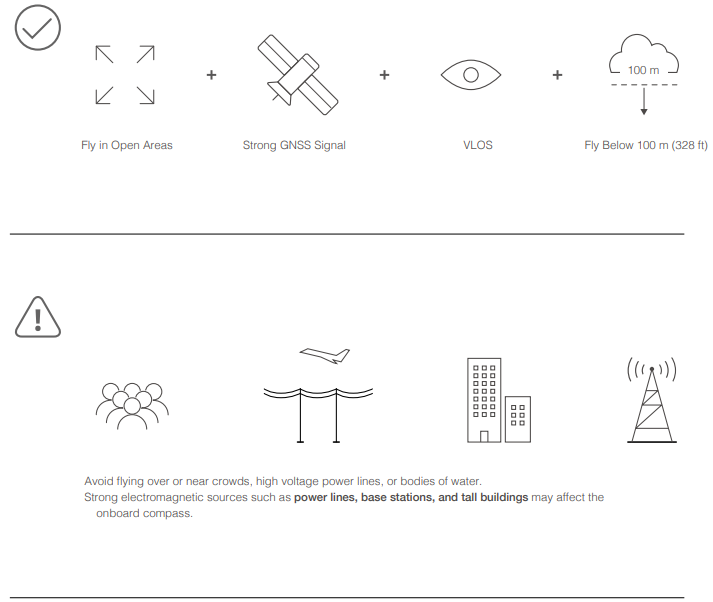
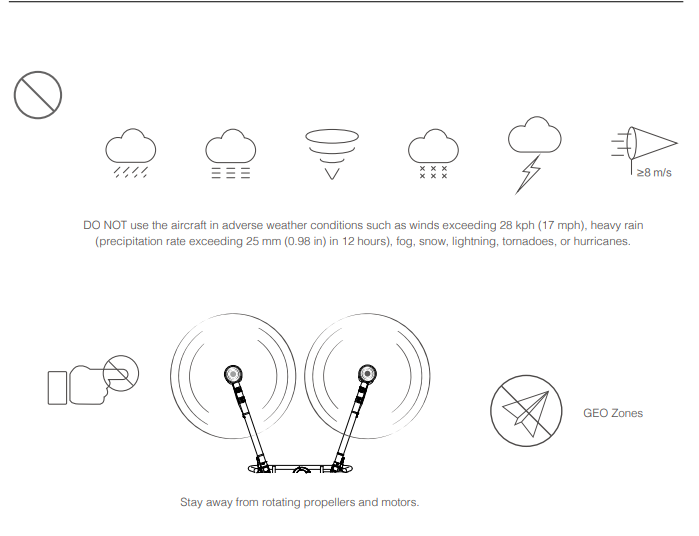
Updating the Firmware
The firmware of the remote controller, aircraft, and other devices such as the battery station can be updated together in DJI Agras. Follow the steps below.
Steps for Updating Firmware
- Power on the remote controller and the aircraft
Make sure that the remote controller has access to the internet via Wi-Fi or a dongle. The firmware file is usually large, so it is recommended to use Wi-Fi. - Check for firmware updates
A prompt appears at the bottom of the home screen in DJI Agras when a new firmware update is available. Tap the prompt to enter the firmware screen. - Connect devices to the USB-A port
Connect the device to the USB-A port on the remote controller to update the firmware of the battery station. Tap the dropdown menu for each device and select the firmware. There will be a check mark on the device displayed in the app when a firmware is selected for the corresponding device. Uncheck the mark to cancel the update. - Update all devices
Tap Update All to redirect to the update screen. The app will download the firmware for all selected devices and update them automatically. - Wait for the update to complete
Make sure all the devices are connected to the remote controller and wait for the update to complete. - Restart after update
After successfully completing the update, restart the remote controller and the aircraft manually.
Alternative Method
DJI Assistant 2 for MG can also be used to update the firmware.
Troubleshooting
- Common Problems: Issues such as poor connectivity, inaccurate GPS readings, or malfunctioning sprayers can occur.
- Solutions: Check for firmware updates, ensure proper calibration, and inspect for physical damage to components like antennas or nozzles.
- Warnings: Always follow safety guidelines when handling chemicals and electrical components. Avoid flying in adverse weather conditions.
Pros & Cons
Pros
- Efficient Spraying System: Optimized for uniform coverage and reduced chemical usage.
- High-Resolution Imaging: Detailed crop health monitoring with the 40MP camera.
- Robust Build: IP67 rating ensures durability in harsh environments.
- Advanced Navigation: Precise flight and payload delivery thanks to advanced sensors.
Cons
- High Cost: Significant investment required for purchase and maintenance.
- Complex Setup: Requires technical expertise for assembly and configuration.
- Dependence on Weather Conditions: Limited functionality in severe weather.
Customer Reviews
Customers have praised the AGRAS T30 for its reliability and efficiency in agricultural tasks. Many users have reported significant reductions in chemical usage and improved crop yields. However, some users have noted the high initial cost and the complexity of the setup process as drawbacks.
Common complaints include occasional connectivity issues and the need for regular maintenance to ensure optimal performance.
Faqs
What is the maximum flight time of the DJI AGRAS T30?
How wide can the AGRAS T30 spray?
What type of camera does the AGRAS T30 use?
Is the AGRAS T30 resistant to weather conditions?
How does the smart spraying system work on the AGRAS T30?
Can I update the firmware of my AGRAS T30?
What kind of controller is compatible with the AGRAS T30?
How do I calibrate my new AGRAS T30?
Can I use different payloads with my AGRAS T30?
What kind of maintenance does the AGRAS T30 require?
Leave a Comment
